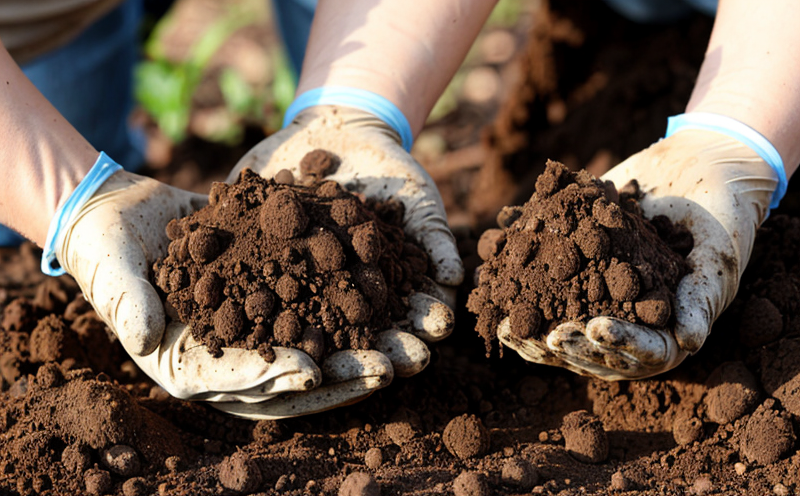WHO Microbial Pathogen Detection in Soil Testing
The World Health Organization (WHO) guidelines emphasize the importance of ensuring soil safety and quality to prevent the spread of infectious diseases. This service focuses on detecting potential microbial pathogens present in soil, which is critical for public health and environmental protection.
Soil can serve as a reservoir for various pathogenic microorganisms such as bacteria, viruses, fungi, and parasites. These organisms may be transferred through direct contact or via contaminated water sources, leading to the spread of diseases like cholera, typhoid fever, and amoebiasis. The detection and quantification of these pathogens in soil are essential steps in assessing potential risks and implementing preventive measures.
Our laboratory adheres strictly to WHO guidelines for testing and employs advanced methodologies and technologies to ensure accurate results. We use culture-based techniques, molecular methods (PCR), and serological assays to identify a wide range of pathogenic microorganisms. Our team of experts ensures that all tests are conducted in compliance with international standards such as ISO 17025.
Our approach is designed to provide comprehensive insights into the microbial content of soil samples, enabling stakeholders to take informed decisions regarding land use and remediation efforts. This service plays a crucial role in safeguarding public health by identifying potential risks early on and facilitating appropriate interventions.
- Culture-based techniques for detecting known pathogens
- PCR (Polymerase Chain Reaction) for sensitive detection of microbial DNA/RNA
- Serological assays to identify specific antibodies against known pathogens
- Compliance with WHO guidelines and international standards like ISO 17025
- Use of advanced laboratory instruments and equipment for accurate results
By offering this service, we contribute significantly to the global effort towards ensuring safe soil practices. Our expertise in microbial pathogen detection enhances the reliability and validity of test outcomes, providing clients with actionable insights that support their decision-making processes.
The significance of this service extends beyond mere compliance; it represents a proactive approach toward protecting public health and promoting sustainable development practices. Stakeholders, including quality managers, compliance officers, R&D engineers, and procurement professionals, benefit greatly from our services as they aid in identifying risks early on and implementing necessary mitigation strategies.
Why It Matters
The detection of microbial pathogens in soil is critical for several reasons. Firstly, it helps identify potential sources of infectious diseases that can affect humans and animals alike. Secondly, understanding the presence and distribution of these pathogens aids in devising effective containment strategies to minimize health risks. Lastly, this service supports regulatory compliance requirements set forth by various governmental bodies.
For instance, the presence of Legionella pneumophila in soil can lead to outbreaks of Legionnaires' disease, while certain strains of Salmonella may cause gastroenteritis or typhoid fever if ingested. By detecting these pathogens early on, we enable quicker response times and more effective intervention measures. This not only protects public health but also reduces the economic burden associated with managing infectious diseases.
Compliance with regulatory standards is another key aspect of why this service matters. Many regions have specific guidelines regarding soil safety and quality control, especially in areas where agriculture or urban development projects are underway. Adhering to these regulations ensures that our clients remain compliant while also enhancing their reputation as responsible stakeholders.
Applied Standards
The testing process for detecting microbial pathogens in soil follows rigorous protocols outlined by the World Health Organization (WHO). These guidelines ensure consistency and accuracy across different laboratories worldwide. The standards we follow include:
- ISO 17025:2017 – This international standard sets out requirements for competence of testing and calibration laboratories.
- ASTM E2986-14 – Provides a protocol for the quantitative enumeration of soilborne pathogens using quantitative PCR.
- EN 15307:2009 – Specifies methods for determining microbial indicators in soil and water.
- IEC 62284-2:2017 – Deals with the sampling, preparation, and preservation of soil samples intended for microbiological analysis.
We ensure that our testing procedures comply with these standards to maintain high levels of accuracy and reliability. Our team remains up-to-date with any updates or amendments made to these guidelines, ensuring continuous improvement in our methods.
Why Choose This Test
- Accurate Detection: We employ state-of-the-art technology including PCR and serological assays to ensure precise identification of microbial pathogens.
- Compliance Assurance: Our tests are conducted in strict adherence to WHO guidelines and international standards, providing peace of mind for regulatory compliance.
- Rapid Turnaround Time: We strive to deliver results quickly without compromising on accuracy or reliability.
- Expertise & Experience: Our team comprises highly skilled professionals with extensive experience in microbial pathogen detection.
- Culture-Based Techniques: Utilization of traditional culture-based methods ensures comprehensive coverage of known pathogens.
- Molecular Methods: Advanced PCR technology allows for sensitive detection of microbial DNA/RNA, even at low concentrations.
- Serological Assays: These assays help identify specific antibodies against known pathogens, providing additional layers of validation.
Selecting this test offers numerous advantages over other options available in the market. With our comprehensive suite of testing methods and strict adherence to global standards, you can be confident that your soil samples will receive meticulous attention throughout every stage of the analysis process.





